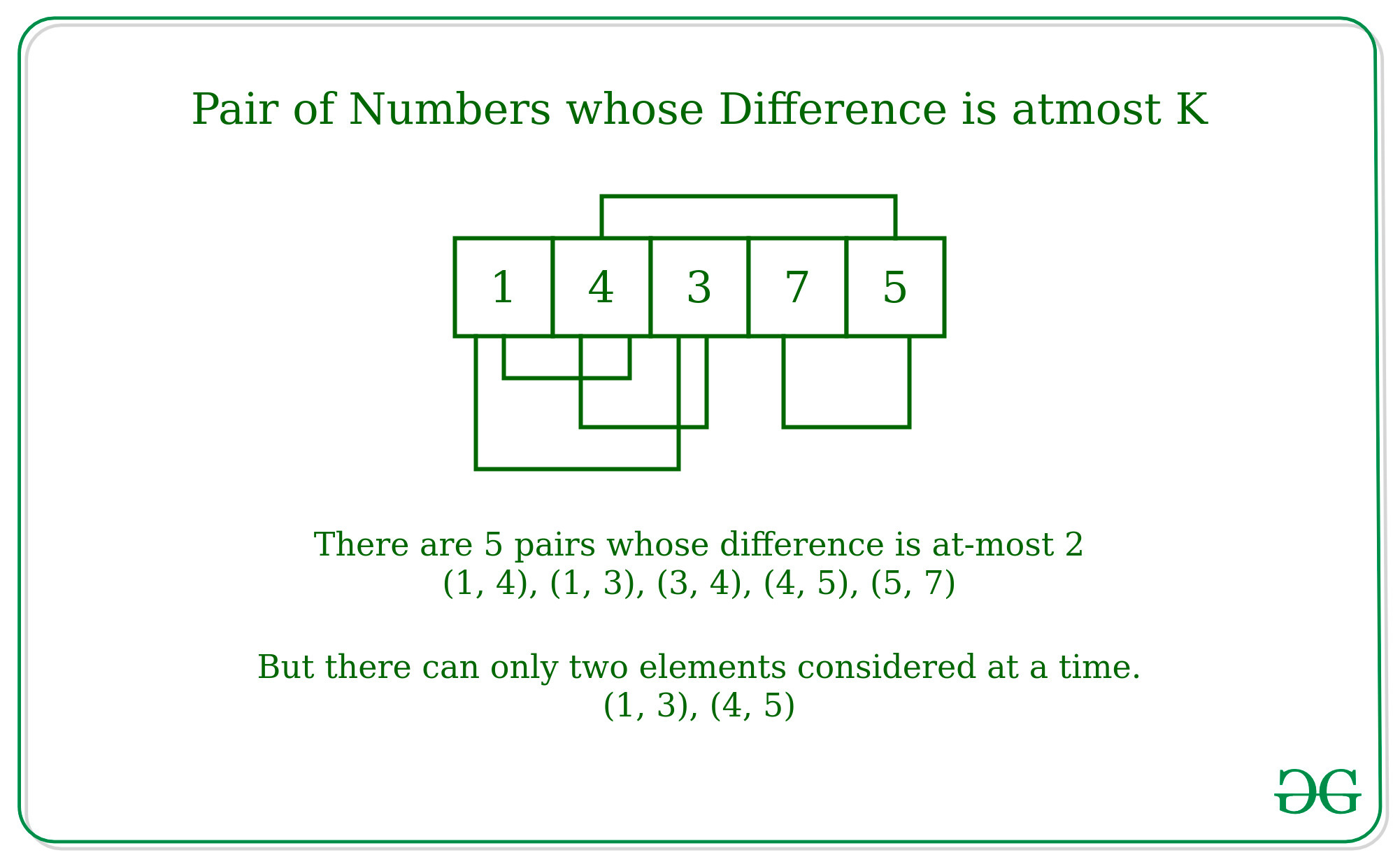给定一个数组arr []和一个数字K ,任务是计算其差小于或等于K的对的数量,这样一个元素只能被考虑为一对。
例子:
Input: arr[] = {1, 3, 3, 9, 4}, K = 2
Output: 2
Explanation:
There are only two pairs whose difference is atmost 2
(1, 3), (3, 4)
Input: arr[] = {1, 4, 3, 7, 5}, K = 2
Output: 2
Explanation:
There are five pairs in the array whose difference is atmost 2,
(1, 3), (3, 4), (4, 5), (3, 5), (5, 7)
But only two of them can be considered at a time because one element
can be taken in a pair only once.
方法:
想法是对数组进行排序并找到相邻元素之间的差异,如果差异最大为K,则考虑该对,并增加计数,然后根据条件,任何元素只能成对存在,如果找到一对,将计数器增加2,以使任何元素仅出现在一对中。
例如:
Given Array - {1, 4, 3, 7, 5}, K = 2
After Sorting Array will be - {1, 3, 4, 5, 7}
Step 1 - i = 0, count = 0
Consider the pair of elements for i and i + 1
Pair - (1, 3), Difference = 3 - 1 = 2
As the Difference is less than equal to 2
count = 1 and i = 2
Step 2 - i = 2, count = 1
Consider the pair of elements for i and i + 1
Pair - (4, 5), Difference = 5 - 4 = 1
As the Difference is less than equal to 2
count = 2 and i = 4
As i is greater than length-2,
there will be no more possible pairs.
算法:
- 使用任何排序算法对数组进行排序,以使连续的元素在一起。
- 将索引计数器(例如i )初始化为零,并运行一会儿循环,直到索引计数器小于(长度– 1)
- 检查索引i和i + 1处元素的差。
- 如果差值小于或等于K,则将索引加2,并将计数器也加1,以立即考虑元素
- 否则将索引加1以考虑下一个元素形成的对。
下面是上述方法的实现:
C++
// C++ implementation to count the
// number of pairs whose difference
// is atmost K in an array
#include
#include
using namespace std;
// Function to count the
// number of pairs whose difference
// is atmost K in an array
int countPairs(int arr[], int k, int n)
{
// Variable to store the count of pairs
// whose difference is atmost K
int pair = 0;
int index = 0;
//int n = sizeof(arr)/sizeof(arr[0]);
// Sorting the Array
sort(arr,arr + n) ;
// Loop to consider the consecutive
// pairs of the array
while(index < n -1)
{
// if Pair found increment
// the index by 2
if (arr[index + 1] - arr[index] <= k){
pair += 1 ;
index += 2 ;
}
else{
index += 1;
}
}
return pair ;
}
// Driver Code
int main() {
int arr[] = {1, 4, 3, 7, 5} ;
int k = 2;
int n = sizeof(arr)/sizeof(arr[0]);
// Function Call
int count = countPairs(arr, k,n) ;
cout << count << endl;;
}
// This code is contributed by AnkitRai01 Java
// Java implementation to count the
// number of pairs whose difference
// is atmost K in an array
import java.util.*;
class GFG
{
// Function to count the
// number of pairs whose difference
// is atmost K in an array
static int countPairs(int arr[], int k)
{
// Sorting the Array
Arrays.sort(arr) ;
// Variable to store the count of pairs
// whose difference is atmost K
int pair = 0;
int index = 0;
// Loop to consider the consecutive
// pairs of the array
while(index < arr.length -1)
{
// if Pair found increment
// the index by 2
if (arr[index + 1] - arr[index] <= k){
pair += 1 ;
index += 2 ;
}
else{
index += 1;
}
}
return pair ;
}
// Driver Code
public static void main (String[] args) {
int arr[] = {1, 4, 3, 7, 5} ;
int k = 2;
// Function Call
int count = countPairs(arr, k) ;
System.out.println(count);
}
}
// This code is contributed by AnkitRai01Python3
# Python3 implementation to count the
# number of pairs whose difference
# is atmost K in an array
# Function to count the
# number of pairs whose difference
# is atmost K in an array
def countPairs(arr, k):
# Sorting the Array
arr.sort()
# Variable to store the count of pairs
# whose difference is atmost K
pair = 0
index = 0
# Loop to consider the consecutive
# pairs of the array
while(index < len(arr)-1):
# if Pair found increment
# the index by 2
if arr[index + 1] - arr[index] <= k:
pair += 1
index += 2
else:
index += 1
return pair
# Driver Code
if __name__ == "__main__":
arr = [1, 4, 3, 7, 5]
k = 2
# Function Call
count = countPairs(arr, k)
print(count)C#
// C# implementation to count the
// number of pairs whose difference
// is atmost K in an array
using System;
class GFG
{
// Function to count the
// number of pairs whose difference
// is atmost K in an array
static int countPairs(int []arr, int k)
{
// Sorting the Array
Array.Sort(arr) ;
// Variable to store the count of pairs
// whose difference is atmost K
int pair = 0;
int index = 0;
// Loop to consider the consecutive
// pairs of the array
while(index < arr.Length - 1)
{
// if Pair found increment
// the index by 2
if (arr[index + 1] - arr[index] <= k)
{
pair += 1 ;
index += 2 ;
}
else
{
index += 1;
}
}
return pair ;
}
// Driver Code
public static void Main ()
{
int []arr = {1, 4, 3, 7, 5} ;
int k = 2;
// Function Call
int count = countPairs(arr, k) ;
Console.WriteLine(count);
}
}
// This code is contributed by AnkitRai01输出:
2
性能分析:
- 时间复杂度:在上述方法中,对数组进行排序需要O(N logN),并且还需要进行一次迭代以计算对的数目为O(N)。
因此,该方法的总体复杂度为O(N logN + N) 。 - 空间复杂度:在上述方法中,没有使用额外的空间,因此该方法的总体空间复杂度将为O(1)